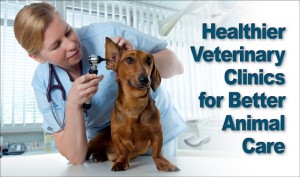Building Healthy Surroundings for Animal Patients
Pre-engineered steel buildings create an atmosphere for improved health and healing in many ways for a vet hospital— as well as other medical or commercial structures. The same health benefits metal buildings afford people also benefit animals recuperating in veterinary hospitals.
Indoor Air Quality
 Indoor air quality (IAQ) is of paramount concern. According to estimates by the Centers for Disease Control (CDC), Americans spend 90% of their time indoors. Yet an Environmental Protection Agency (EPA) study found harmful indoor pollutants could be up to 100 TIMES greater indoors than outdoors.
Indoor air quality (IAQ) is of paramount concern. According to estimates by the Centers for Disease Control (CDC), Americans spend 90% of their time indoors. Yet an Environmental Protection Agency (EPA) study found harmful indoor pollutants could be up to 100 TIMES greater indoors than outdoors.
It stands to reason that improving air quality in a vet hospital benefits both the animal patients and their professional caregivers.
Most indoor air quality irritants come from inside the building itself.
Engineered wood products allow the lumber industry to stretch dwindling forests. Fabricated wood products like oriented strand board, plywood, and engineered wood products contain volatile adhesives that outgas into the building, emitting volatile organic compounds.
Steel material contain no adhesives or glues. An inorganic substance, steel never outgasses or releases volatile organic compounds. Hence, steel-framed veterinary hospitals and clinics provide improved quality.
f course, pet hair and dander are irritants and indoor air pollutants. Animal care facilities require scrupulous cleaning to keep loose dander and hair at a minimum.
High-quality air filtration systems are necessary in animal hospitals, particularly in kennel areas.
Termites
Termites love to munch on trees, be it in your yard or as framing in your building.
Lumber requires pressure treating with harsh chemicals to deter termites. Building codes in most of the country call for the injection of dangerous chemicals in the soil around wood-framed structures to reduce the chances of a termite invasion. Periodic termicide treatments must be applied, too.
No termite can make a meal of steel.
Steel vet hospitals and other commercial structures need no treatment with cancer-causing termicides that can leech into soil, outgas into the building, and compromise IAQ.
Mold and Mildew
Bacteria, mold, and mildew also contaminate indoor air quality— especially when excess moisture is present. Confined animals create plenty of moisture, increasing the risk of bacteria growth and mold.
Mold and other fungi need only two things to flourish an organic material to feed upon and moisture. As an organic material, wood creates the perfect breeding ground for mold.
Again, because steel is inorganic, it does not support mold or any other fungi. In a steel building with superior waterproofing features (such as RHINO’s steel building system), mold should never be a problem.
Noise Pollution
Noise pollution is a fact of life— especially in urban environments. Increased noise levels affect not only hearing, but also stress levels for those exposed— including animals.
Every vet knows outside noise stirs up the animal guests in a clinic. Some animals respond by adding their own voices to the din. Others, already traumatized by illness and a visit to the vet, tremble in fear.
Metal buildings use commercial-grade steel, which creates deep wall cavities. Thicker walls leave room for extra-thick insulation, drastically reducing the penetration of outside noise. (Equally important to the surrounding neighborhood, the heavier insulation cuts down on the noise escaping the building, too.)
As an added bonus, the denser insulation (as in RHINO’s optional Pro-Value System), reduces energy usage, cutting the clinic’s operating costs.
Adding suspended acoustic ceiling tiles with a high noise reduction co-efficient (NRC) rating is another way to pull the plug on interior noise. A strong NRC tiles ceiling absorbs up to 75% of interior noise.
Isolating kennel areas from reception, exam rooms, offices, and surgical areas, helps mute the noise, too. Using glass-front kennel cages helps muffle sound as well.
Natural Lighting
Studies conducted in hospitals found natural lightning speeds up recovery time in humans. It is reasonable to assume natural lighting would also shorten the recovery for animals. People working in businesses with natural light tend to perform better, according to recent studies.
EnergyStar windows allow light in while maintaining energy-efficiency.
Steel building easily accommodate all types of windows, as well as skylights.
Keep in mind, however, that any movement beyond the window distracts and disturbs four-legged patients. Natural views of trees or a garden will nurture animals as well as workers. Face windows away from high-traffic areas. Cover windows with blinds to control the lightning and obscure movement, where necessary.
As for arterial interior lighting, choose full-spectrum florescent bulbs over traditional lighting to promote faster healing.
Call RHINO today…
Building with steel promotes a healthier environment for your clinical staff, your clients, and their pets.
Speak with a metal building specialist for more information on building a vet hospital or clinic — or any other low-rise commercial or industrial project. The RHINO number is 940.383.9566.
